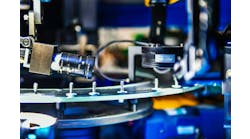What is the role of power and force limiting, as well as speed and separation monitoring, in making collaborative robots safe? With robotics playing such a pivotal role in the future of discrete manufacturing, we asked a seasoned panel of industry experts for their insights and predictions on the role of robots.
Click here to meet the panel of experts.
Q: What makes the collaborative robot safe for human interaction?
Carole Franklin: When implemented according to the guidelines in ISO/TS 15066, the collaborative robot system might utilize one or a combination of the following: power and force limiting, and speed and separation monitoring.
With power and force limiting, the power and/or force of the robot’s motion is constrained to levels that will avoid causing pain to a human, even if contact were to occur. ISO/TS 15066 provides data on pain threshold levels so that we now know where to set those limits on the power and force of the robot’s movement.
With speed and separation monitoring, on the other hand, contact is prevented since the robot is made aware of the human presence and takes action to maintain a safe distance, or shut down if the safe distance cannot be maintained. For example, if the human takes a step forward, the robot might move an equal distance backward, maintaining the safe distance by means of this dance.
Corey Ryan: Collaborative robots typically implement one of two main strategies for safety. Most robots carry only a very low payload at a slow speed in order to minimize the risk of injury. Others can carry higher payloads at higher speeds but utilize sensors to manage the robot speed relative to the distance from people. When people are far from the robot, it can run quickly but slows as people approach and eventually stops to prevent robot-human collisions.
Craig Souser: The collaborative robots are lightweight and slow, so they won’t hurt a great deal if they do contact you, and they have advanced sensing to assist in limiting the impact forces if there is a collision with a human.
Allan Hottovy: Safety light curtains, scanning systems and enclosing robots in cages with all doors and gates monitored by machine-safety door interlocks are used to improve safety around robots. It’s important for companies to do a thorough risk analysis on their plant equipment and to apply safety products and philosophies according to the recommendations their safety department dedicates per local, state and federal regulations.
John Keinath: Collaborative robots can safely monitor their speed and position. When operator safety devices like safety laser scanners are used to detect where an operator is in the work space, the collaborative robot can slow down or even stop as the operator gets closer to the robot. Some collaborative robots on the market today can detect when forces are applied to them, which allows the robots to safely stop when they come in contact with a person.
A risk assessment must always be performed to determine if the operator is exposed to any hazards when interacting with a robot. Even if the robot is capable of stopping with the touch of a human, there may still be potential dangers. For example, the speed of the robot and the tasks the robot is performing need to be considered. If a robot hits someone while it is moving at high speeds or carrying a large payload, it could possibly cause a bruise or even break a bone before it has time to safely stop. Likewise, if the robot is carrying something sharp, it could cut someone. While collaborative robots provide an additional level of safety, they may not provide all the safety measures required for the application. A good risk assessment will determine what is required.
Garrett Place: Most collaborative robots subscribe to the power-and-force-limited methodology to provide a safe environment. The power side of this equation is the weight capacity. If heavy objects can't be carried, they cannot harm the operator. The second factor in this equation, the force limitation, is related to a stopping action upon contact. The robot's soft skin detects when anything in the path of the robot actually contacts the robot, forcing a stop in motion. This action is also a limiter to the overall speed of the bot.
Alex Bonaire: The key to collaborative robot implementation is the risk assessment for the overall application. Simply having a robot that is slow or limited in force does not make it safe. If the process itself is inherently dangerous, then it does not matter how collaborative a robot is designed to be. The amount of force, speed and operating range of a robot must be monitored and controlled by a safety-rated system or limited by design. In addition to the design of the tooling used both on and off of the robot within the work cell, the process must be safe while in operation.
Scott Mabie: Whether you should cage your collaborative robot and how to set the cobot’s adjustable safety features always depends on a risk assessment of the entire robot application and how it relates to where human workers are located. A robot in itself is never safe. The same robot could be welding with a blowtorch one day and doing pick-and-place with a soft pneumatic suction cup the next. That’s why a risk assessment of each application is imperative.
David Arens: Surface sensors and 3D prediction of collision and human and robot monitoring of position and motion all play a role. Humans are much slower to react than the robot sensor system, and prediction of the collision path avoids the collision and prevents the unwanted interaction of human and robot physical space.
Roberta Nelson Shea: A collaborative robot is not safe for human interaction by itself. There are four characteristics that define a robot system that can be operated alongside a human—that is, in a collaborative application. They are the safety-rated monitored stop; hand-guiding operation; speed and separation monitoring; and power and force limiting.
In the safety-rated monitored stop, the robot system is able to perform a protective stop that is safety-rated and monitored, allowing operators to hand parts directly to the end effector—the device at the end of a robot arm.
For hand-guiding operation, this emerging technology allows operators to manually control robot movement while it is in automatic mode. The robot system's speed is reduced, and it can make safety-rated, monitored stops, allowing an operator to change the robot’s position or location.
With speed and separation monitoring, the robot system maintains the necessary distance from an operator using protective devices, such as safety scanners. Its speed is safely reduced, and it comes to a safety-rated monitored stop before the robot system can make contact with the operator.
Regarding power and force limiting, the robot system is limited in speed and force so that any contact by the robot system will not harm the person. This attribute is the most challenging, especially considering the many different robot applications in a factory.
However, these safety features don’t automatically make a robot or robot system suitable for collaborative applications. Before using robot systems collaboratively, engineers need to conduct a thorough risk assessment to identify and mitigate all potential hazards. For power- and force-limited applications, risk assessment is expanded to analyze each body region that could be contacted. Engineers should consult standards ISO 10218-1, ISO 10218-2 and ISO TS15066 to help ensure that a collaborative robot application could be safe for human interaction.
Homepage image courtesy of ddpavumba at FreeDigitalPhotos.net




